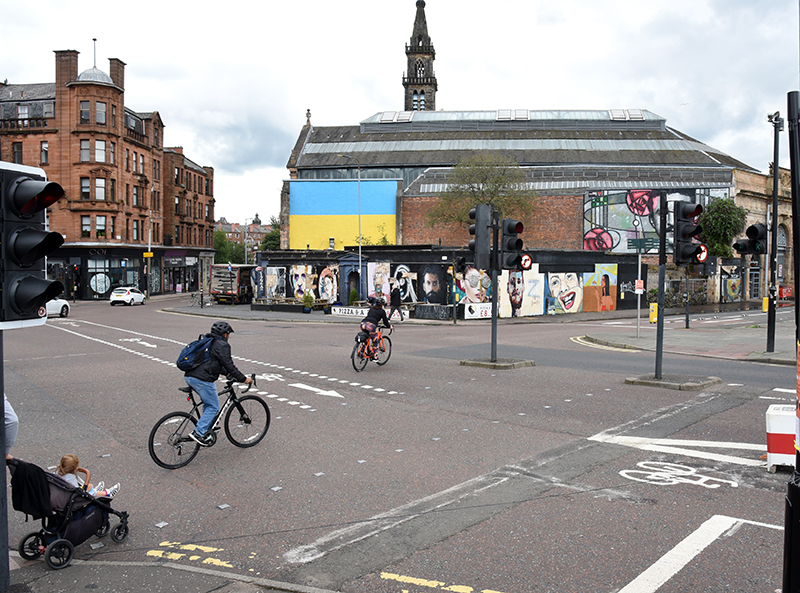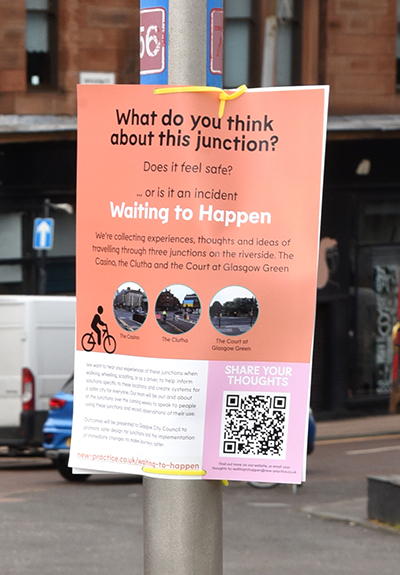
RESPONDENTS to a new campaign launched in memory of a young architect who lost her life whilst cycling in Glasgow city centre have been hailed for the genuine care shown to the initiative.
Launched by New Practice, the architecture firm received over 500 responses within two weeks of beginning its Waiting to Happen campaign, which looks to gather data on how to improve the safety of three junctions identified as being dangerous in Glasgow city centre.
The campaign comes in memory of 22-year-old Emma Burke Newman, who tragically lost her life in an incident whilst cycling in the Broomielaw area of the city in January this year.
Despite only being at the beginning of her career, the talented architect had already helped deliver social value programmes on housing and masterplan projects across London and Portsmouth before moving to Glasgow to become a designer at New Practice and study at Glasgow School of Art.
She spoke openly of her ambitions to create ‘more equitable’ cities and ensure that communities had a sense of ‘belonging’ and ‘pride’ in their neighbourhoods, stating that it’s ‘always a joy’ to learn about someone’s lived experience of their neighbourhood and to then advocate for them in the design process.

Meeting Project Scotland at the junction by Gorbals and Clyde Street, Becca Thomas, creative director at New Practice, described Emma as ‘kind’, ‘intelligent’, and ‘just really amazing’, before telling of the admiration she had for Emma whilst watching her become the adult and professional she set out to be.
Becca, alongside her colleagues, have been taking regular trips to the city centre to gather responses from cyclists and pedestrians on the junction at Clyde Street, as well as at Broomielaw, and Crown Street. Digital responses have also been gathered online and through QR codes available at the junctions.
“One of the things that has been really interesting is that the comments reflect a lot of our own thoughts,” Becca explained, before telling of how the practice is made up of experienced cyclists. “We sat in the office and spoke at length about what project we wanted to do in Emma’s memory. We have pages and pages of notes from those meetings and the comments we’re getting reflect all of our own experiences – so we know we weren’t just sitting in a room getting annoyed because we suffered a loss and are grieving; we’re getting the same comments over and over again, which I think does highlight these are truly incidents that are waiting to happen.”
The campaign has been described as ‘quite the leap’ for the practice, with it essentially being activism as opposed to its usual role of working for a client. Key to Becca’s brief was that the team didn’t think up their own solutions, so as to ensure they never subconsciously drifted towards responses which aligned with their own vision for the junctions.

With responses continuing to pour in, Becca said it is clear there is ‘genuine care’ being shown from those giving their opinions. Based on the responses, the practice said that it doesn’t expect huge infrastructure changes to come as a result of the campaign, but a more joined-up and sensible approach which ensures everyone on the road knows what they are doing, all cycling infrastructure is aligned, cyclists aren’t put in a position where they’re in the same lane or near heavy goods vehicles, and waiting times at crossings are reduced to reduce the tendency for individuals to take risks when crossing roads.
“Glasgow has historically been a car-centric city; you can see that with the M8,” Becca added. “However, that’s changing. But we’re working against 60 years of history and 60 years of how the roads have been planned, so it’s a big shift. I think the city has done a really good job getting this far; there’s loads of great, new infrastructure – it just doesn’t all join up or there’s bits where it’s not clear where you should be as a cyclist and that can lead to a sense of ‘what am I doing’ and car drivers not knowing where a cyclist is going.”
Much of this can be put down to the different iterations of active travel routes in Glasgow that have been delivered over the years, such as the now permanent Spaces for People measures created during lockdown, through to the shared paths from the older active travel system in the city, local infrastructure from the council, and national infrastructure in the form of national cycleways. Much of this doesn’t always link up, which can leave cyclists having to make split second decisions when an active travel route abruptly ends.

Once the response gathering phase ends, New Practice will present the data to Glasgow City Council’s active travel committee. They already have the backing of councillor Angus Miller, convener for transport and city centre recovery, and councillor Holly Bruce, vice chair of the environment and liveable neighbourhoods city policy committee.
“You’ll never get a perfect journey for a single person because that perfect journey would block someone’s else’s journey,” Becca concluded. “So, it will always be a massive amount of compromise in these places and it’s important that we take that data to the council with that understanding.
“I don’t expect them to make massive changes; I expect them to make really small tweaks that will improve the safety and possibility of getting to places easily on foot or wheels.”
Click here to share your thoughts on how the three junctions can be made safer.











